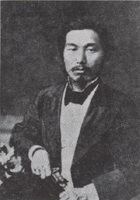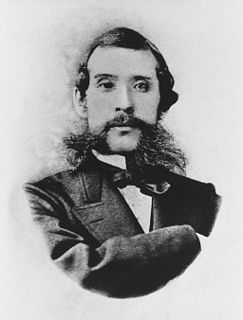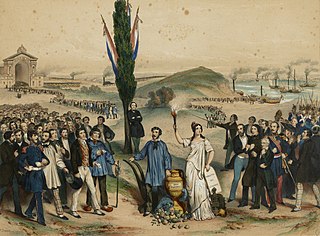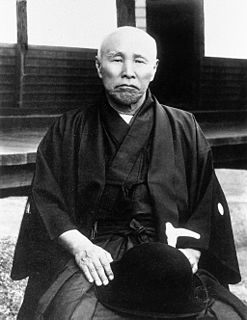
The National Diet is Japan's bicameral legislature. It is composed of a lower house called the House of Representatives, and an upper house, called the House of Councillors. Both houses of the Diet are directly elected under parallel voting systems. In addition to passing laws, the Diet is formally responsible for selecting the Prime Minister. The Diet was first convened as the Imperial Diet in 1889 as a result of adopting the Meiji Constitution. The Diet took its current form in 1947 upon the adoption of the post-war constitution, which considers it the highest organ of state power. The National Diet Building is in Nagatachō, Chiyoda, Tokyo.

The House of Representatives is the lower house of the National Diet of Japan. The House of Councillors is the upper house.

Nakae Chōmin was the pen-name of a journalist, political theorist and statesman in Meiji-period Japan. His real name was Nakae Tokusuke. His major contribution was the popularization of the egalitarian doctrines of the French philosopher Jean-Jacques Rousseau in Japan. As a result, Nakae is thought to have been a major force in the development of liberalism in early Japanese politics.
The Jiyūtō is the name of several liberal political parties in the history of Japan, two of which existed in the Empire of Japan prior to 1945.
The Japanese political process has three types of elections: general elections to the House of Representatives held every four years, elections to the House of Councillors held every three years to choose one-half of its members, and local elections held every four years for offices in prefectures, cities, and villages. Elections are supervised by election committees at each administrative level under the general direction of the Central Election Administration Committee, an attached organization to the Ministry of Internal Affairs and Communications (MIC). The minimum voting age in Japan's non-compulsory electoral system was reduced from twenty to eighteen years in June 2016. Voters must satisfy a three-month residency requirement before being allowed to cast a ballot.
Political parties appeared in Japan after the Meiji Restoration, and gradually increased in importance after the promulgation of the Meiji Constitution and the creation of the Diet of Japan. During the Taishō period, parliamentary democracy based on party politics temporarily succeeded in Japan, but in the 1930s the political parties were eclipsed by the military, and were dissolved in the 1940s during World War II
The Government of Meiji Japan was the government that was formed by politicians of the Satsuma Domain and Chōshū Domain in the 1860s. The Meiji government was the early government of the Empire of Japan.
The General Election Law was a law passed in Taishō period Japan, extending suffrage to all males aged 25 and over. It was proposed by the Kenseitō political party and it was passed by the Diet of Japan on 5 May 1925.
The Kenseitō was a political party in the Meiji period Empire of Japan.

Japanese general election of 1890 was the Empire of Japan’s first general election for members of the House of Representatives of the Diet of Japan. It was the first example of a popularly elected national assembly in Asia

Okazaki Kunisuke was a politician and cabinet minister in the late Meiji and Taishō period Empire of Japan.

Ōe Taku was a samurai, bureaucrat, politician, entrepreneur and social activist in the late Meiji and Taishō period Empire of Japan. He is noted as one of the more progressive figures of the early Meiji period, although his record is complex. His wife was the younger daughter of Gotō Shōjirō.

Hayashi Yūzō was a politician and cabinet minister in the pre-war Empire of Japan.

Kōno Hironaka was a politician and cabinet minister in the Empire of Japan.

Viscount Watanabe Kunitake was a Japanese politician, cabinet minister and deputy Prime Minister, who lived in the Meiji and Taishō periods. Noted primarily for his role as finance minister, he was also the younger brother of Count Watanabe Chiaki.

Baron Shirane Sen'ichi was a politician and bureaucrat in Meiji period Empire of Japan. In 1907, he was raised to the rank and title of danshaku (baron) under the kazoku peerage system.

The 25th regular election of members of the House of Councillors will be held on July 2019 to elect 124 of the 245 members of the House of Councillors, the upper house of the then 710-member bicameral National Diet of Japan, for a term of six years.



















